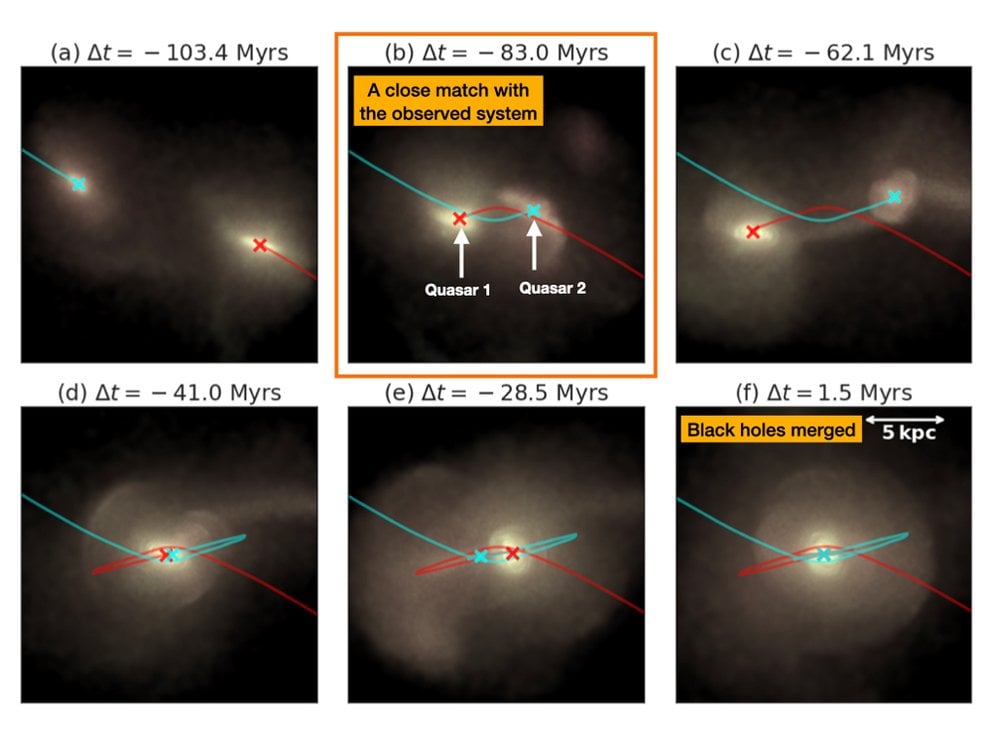NASA’s Hubble Space Telescope made an unexpected discovery — a pair of gravitationally bound quasars inside two merging galaxies that existed when the universe was just three billion years old.
An international group of researchers, including cosmologists from Carnegie Mellon University, reported the discovery in the issue of Nature.
This artist’s concept shows the brilliant glare of two quasars residing in the cores of two galaxies that are in the chaotic process of merging. The gravitational tug-of-war between the two galaxies ignites a firestorm of star birth. Image credit: NASA, ESA, Joseph Olmsted (STScI).
Quasars are among the brightest objects in the universe and are created by invisible supermassive black holes, which live at the center of large galaxies. As black holes feed, they emit energy that heats up and illuminates the dust and gas that they consume.
Researchers just recently have been able to see quasars in the early universe due to the power of the current generation of telescopes like Hubble. Double quasars have rarely been observed even through the best telescopes, but are thought to be a tell-tale sign of a galaxy merger.
“Understanding how black holes form, the first quasars emerge, and how they grow along our cosmic histories is one of the greatest theoretical and observational challenges of modern astrophysics,” said Tiziana Di Matteo, professor of physics and director of Carnegie Department of Physics.
“Quasars are small in size but play a fundamental role in how galaxies form and evolve into their present state. Observing early quasars, particularly in particular pairs, helps us understand how cosmic structures first form in our universe and the basic processes by which black holes grow.”

A visualization of a double quasar evolution from the Carnegie Mellon simulation closely matches the system observed by the Hubble Space Telescope. The background shows the host galaxies of the quasars, and the colored lines and crosses follow the trajectories of the supermassive black holes powering the quasars. This set of images follows the evolution of the pair for a hundred million years, until the supermassive black holes merge in the last panel. Credit: Carnegie Mellon University/Nianyi Chen.
The quasar pair observed by Hubble telescope comes from a time period known as “cosmic noon,” which is believed to be the peak of star formation and black hole growth. While astronomers believe that galaxies and black holes merged frequently during this time, they have only observed a few double quasars with the help of modern telescopes.
“If we observe more double quasars, we can begin to put limits on theories about early black hole growth and galaxy assembly,” Di Matteo said.
Key to furthering this research is cosmological simulations. Di Matteo is a leader in the field. For the simulations, her team seeds a computer program with conditions about the early universe. As the simulation runs, researchers can witness possible scenarios about how the universe and given objects within the universe have evolved over time.
“Observations give us only a single snapshot in time,” said Nianyi Chen, a doctoral student working with Di Matteo in Carnegie Mellon’s Department of Physics.
“In this case we just see the double quasar at one point in its life and from one angle. And that picture is blurred by instrumentation and matter. From a simulation we have access to much richer temporal and spatial information. In a way it’s like reconstructing a 3D movie from a single picture.”
Scientists used computer models to understand how double quasars form, and where they form naturally in the universe. Because double quasars are so rare, with maybe a few per million galaxies, the computer simulation needed to contain at least a million galaxies in order to attempt to capture a handful of double quasars.
“Every galaxy must be modeled in exquisite detail, down to the very central inner regions, otherwise won’t be able to tell how any double quasars form. This level of detail is present all over the vast simulated universe, and this makes the calculation enormously challenging,” Di Matteo said.
Di Matteo co-developed the galaxy formation simulation called Astrid, one of the largest cosmological simulations ever made. And she was awarded a Large Resource Allocation on TACC’s Frontera system, the most powerful academic supercomputer in the U.S.
“Astrid is currently the only simulation with both the size and the level of physical realism (and associated resolution) needed to make predictions for these rare systems,” Di Matteo said.
“Using the largest queue on Frontera we have been able to run Astrid on 250,000 Cascade Lake CPU cores. Using TACC resources to store and analyze the petabytes of data produced by Astrid is allowing us to discover the origins of stars, galaxies and how dual quasars have an important role.”
The Hubble team used the Astrid simulations to better understand what the telescope saw and what it could mean. The simulation began from when the universe was only about 10 million years old — a time before any galaxies had been born — and ran until the universe was about 4 billion years old — shortly after the time the double quasar was observed.
Their simulation revealed valuable information about the properties of the quasar pairs and the supermassive black holes and galaxy systems where they live.
“In our simulation, we can trace the double quasars through their entire lifetime and answer questions about how they were born, how they evolved and what their future looks like,” Chen said.
Chen noted that the simulation can be used to predict whether or not the merger of the double quasars will produce gravitational waves, which will be heard by future detectors like the Laser Interferometer Space Antenna. Pairing the two will provide even richer data about the double quasars and the merger of their galaxies.
Source: TACC

